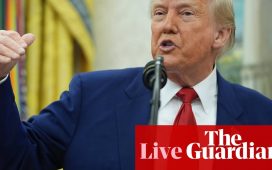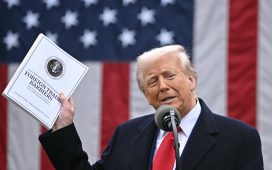US stock markets close in a rally
After a tumultuous week, US stock markets just closed for the week on a high note. The Dow went up 600 points today, while the S&P 500 and Nasdaq Composite were up 1.8% and 2%, respectively.
Over this week, all three indexes rose substantially, largely after Donald Trump paused many of his tariffs. This week:
-
The Dow went up 6%, or over 2,300 points.
-
The S&P 500 jumped 8.2%.
-
The tech-heavy Nasdaq topped 11.6%.
It’s a huge rally after volatile drops in the market, but it’s unclear how long the upswings will last, particularly because the markets have proven so sensitive to the uncertainty around Trump’s policies.
Key events
Summary
Here’s a quick overview of everything that’s happened today:
-
Stock markets around the world continued to climb after Donald Trump delayed the harshest of his tariffs. The tech-heavy Nasdaq Composite index closed over 11% up for the week after a rollercoaster week.
-
But there are many new indicators that the US economy remains on shaky ground: the US dollar index slipped to a three-year low, US treasury yield climbed up and consumer expectations on inflation rose to its highest level in four decades.
-
China announced that it is placing a 125% tariff on American imports, in retaliation for the 145% tariff Trump placed on Chinese imports.
-
The White House said that there is “great optimism in this economy”, despite the volatility seen in the stock market and said that Trump’s tariffs are a “proven economic formula” that will bring countries to the negotiation table.
US stock markets close in a rally
After a tumultuous week, US stock markets just closed for the week on a high note. The Dow went up 600 points today, while the S&P 500 and Nasdaq Composite were up 1.8% and 2%, respectively.
Over this week, all three indexes rose substantially, largely after Donald Trump paused many of his tariffs. This week:
-
The Dow went up 6%, or over 2,300 points.
-
The S&P 500 jumped 8.2%.
-
The tech-heavy Nasdaq topped 11.6%.
It’s a huge rally after volatile drops in the market, but it’s unclear how long the upswings will last, particularly because the markets have proven so sensitive to the uncertainty around Trump’s policies.
Some small businesses are expressing their frustrations over Donald Trump’s tariffs by adding a tariff surcharge onto their products, to make clear that the price increases they’re seeing are due to Donald Trump’s tariffs.
“We think transparency is the way to go here and I am giving Trump full credit his decision to add this tariff to all US consumers,” wrote Ryan Babenzian, the CEO of Jolie Skin Co, which sells shower heads that filters water, on Linkedin. The company will add a “Trump Liberation Tariff” charge onto their products next week.
It’s reminiscent of when restaurants, in the middle of the Covid-19 pandemic, added surcharges to bills to offset costs used to manage the virus.
“Given all the uncertainty around tariffs and worries about when and by how much prices will go up, shoppers could welcome the transparency of line item tariff surcharges, and they’ll become normalized as more brands adopt them,” Sky Canaves, an analyst at EMarketer, Inc, told Bloomberg.
US Customs and Border Control (CBP) is the federal agency responsible for collecting tariffs when imported goods arrive at the US border.
But importers say that a glitch in the system has meant that they have not started paying tariffs yet, despite Donald Trump saying that the tariffs, particularly the 145% tariffs on China, are already in place.
According to CNBC, the glitch comes from CBP currently not being able to tell which ships are exempted from the tariffs, because they were “on the water” before the tariffs went into effect, and those that were shipped out after the tariffs.
“Social media posts are not law,” Jarred Varaelli, a vice president at Savino Del Bene, a logistics firm. “With the constant changes to the regulations, all customs brokers in our industry have a difficult task ahead of them.”
CBP told CNBC that they will issue an update once the issue is resolved, which means the agency is likely still working out exactly how to carry out the tariffs that are still in place.
Boston Federal Reserve CEO Susan Collins, and a member of the Fed’s Federal Open Market Committee (FOMC) which sets interest rates, told the Financial Times that the Fed “would absolutely be prepared” to stabilize the economy amid volatility.
“We have had to deploy, quite quickly, various tools,” she said. “We would absolutely be prepared to do that as needed.”
But while the Fed would typically cut interest rates, making borrowing money cheaper and encouraging economic activity, to deal with large fluctuations in the market, Collins said that emergency rate cuts are likely not in the Fed’s future because of the risk of higher inflation.
Collins said that it’s likely that inflation could push above 3% this year. Yesterday, inflation in March was revealed to be 2.4%, a 0.4% drop from February.
Let’s dive in for a second into the University of Michigan consumer sentiment survey that was released today.
Typically, the survey is released at the end of each month, but a special report was released to capture sentiment around Donald Trump’s trade war escalations.
And things aren’t looking so good. Consumer sentiment has been falling for the last four months, dropping 30% since December 2024. The number of consumers who expect unemployment to rise over the next year is the highest it’s been since the 2008 recession. And inflation expectations for the year ahead soared in a matter of weeks: from 5% in March to 6.7% by early April.
“Consumers report multiple warning signs that raise the risk of recession: expectations for business conditions, personal finances, incomes, inflation and labor markets all continued to deteriorate this month,” said survey director Joanne Hsu in a statement.
For context, inflation expectations in April last year was 3.2%, and consumer sentiment was measured at 77.2, compared to 50.8 at the beginning of this month.
It will be interesting to see how this drop in consumer sentiment will relate to voter sentiment in the future. Trump’s approval ratings have dropped across the board since his “liberation day” tariff announcement April 2, but only time can tell whether consumer and voter sentiments will rise after Trump’s pause on the reciprocal tariffs.
What’s happening with the US treasury bond market is a pretty big deal.
Treasury bond yields rose on Friday, a sign of further instability in what’s supposed to be a very safe financial asset to hold.
The benchmark is the 10-year treasury bond, the yield of which rose to 4.6% today, over half a percentage point since last week.
This is a big deal because the yield on treasury bonds are closely tied with the cost of other loans, like mortgages or car loans. So if the yield rises, loans like mortgages are likely to go up as well.
That overall leads to a contractionary economic environment – less people are buying homes and investing money in general.
Yield rates also point to inflation expectations. Bloomberg says this is the largest surge in the yield rate since the 1980s, when inflation peaked to 14%.
Minneapolis Federal Reserve president Neel Kashkari explained it to CNBC on Friday: “If the trade deficit is going down, it could be that investors are saying, ‘Okay, America no longer is the most attractive place in the world to invest’, and then you would expect to see bond yields go up.”
So the fact that bond yields are going up – and the dollar is depreciating, and the stock market is making historical fluctuations – points to some serious instability in the economy.
White House press secretary: ‘Great optimism in this economy’
The White House held its daily press briefing this afternoon, fielding questions about tariffs and the economy. The overall sentiment: “There is great optimism in this economy”.
“This is a proven economic formula,” press secretary Karoline Leavitt said.
It’s a line the White House continues to repeat even as volatility in the stock market appears to have rattled investors.
Answering a question about US bonds, which is supposed to be one of the world’s most stable assets, and how they’re decreasing in value, Leavitt said that treasury secretary Scott Bessent is “keeping a very close eye on the bond market”.
Leavitt maintained that Trump’s tariff negotiations have so far been a success, saying that “15 offers are on the table” and the White House has heard from over 75 countries over deals.
Even when it comes to China, which slapped a 125% tariff on American exports, Leavitt said that Trump is “optimistic”, though could not give any details on how a deal with China could be made.
US stocks pick up during midday trading
US stocks are picking up as we enter midday trading:
It’s unclear if this upswing will last into this afternoon. It’s a slight turnaround from this morning, as stocks went down on news that consumer sentiment and inflation expectations cratered in April.
The University of Michigan just released the results of a new consumer sentiment survey that shows consumers in April expect the inflation rate to climb to 6.7% – the highest expected level in over four decades.
Falling consumer sentiment is a bad sign for the economy, as it typically means that people will be spending less, especially if they anticipate prices climbing, which could slow down the overall economy.

Phillip Inman
Donald Trump’s tariff war has spooked stock markets and heightened fears of a recession in the US and Europe. But neither factor appears to have been what motivated the president’s sudden volte face this week, when he paused most of his “liberation day” border taxes for 90 days.
The fact Trump could not ignore was a mass sell-off by investors of US government bonds. But what exactly are bonds, how are they traded – and why are they so central to the current crisis?
Ministers should focus on rebuilding bridges with the EU, UK Labour politicians have said after a senior adviser to Donald Trump downplayed the prospect of a breakthrough with the US.
MPs said the government should “prioritise our trading relationship with the EU” and “get a sugar-rush of growth” instead of banking on the prospect of preferential treatment from Washington.
Trump imposed 10% tariffs on all UK exports this month, with several other markets, including the EU, facing steeper rates. After financial markets plummeted, the US president announced a temporary reprieve on Wednesday, slashing tariffs on almost all other countries to his baseline of 10%. Car, steel and aluminium imports continue to face a higher tariff of 25%.
The government is in advanced negotiations with the US over a trade deal to secure more favourable arrangements for the UK. However Kevin Hassett, an economic adviser to Trump, told CNBC on Thursday that any deal that would persuade the president to go below 10% would need to be “extraordinary”.
Asked if she was losing confidence in the prospect of a US trade deal, Rachel Reeves told reporters on Friday that “we continue to engage with our counterparts in the United States”.

Marina Dunbar
Several senior Senate Democrats have written a letter asking the Securities and Exchange Commission (SEC) to investigate whether Donald Trump violated securities laws and engaged in insider trading and market manipulation while switching course on his global tariffs.
“We urge the SEC to investigate whether the tariff announcements, which caused the market crash and subsequent partial recovery, enriched administration insiders and friends at the expense of the American public and whether any insiders, including the president’s family, had prior knowledge of the tariff pause that they abused to make stock trades ahead of the president’s announcement,” said the letter, led by Massachusetts senator and former presidential candidate Elizabeth Warren.
Early Wednesday, Trump announced on social media: “THIS IS A GREAT TIME TO BUY!!!” The post was written at a time of severely volatile market trends and US indices down.
Hours after his post, the US president abruptly announced a 90-day pause on many tariffs. The move sent the US’s S&P 500 back up several percentage points in just minutes. Wednesday ended up marking the best day for the S&P 500 since the recovery from the 2008 financial crisis.
The letter was also signed by Senate minority leader Chuck Schumer, finance committee ranking member Ron Wyden, the Arizona senators Mark Kelly and Ruben Gallego, and California’s Adam Schiff.

Richard Partington
In the global fallout from Donald Trump’s “liberation day” tariff announcement, it appears nowhere is safe. Crashing share prices, a sell-off in bonds and currency chaos erasing trillions of dollars of wealth in a matter of days.
On Friday the dollar fell by more than 1% relative to a basket of other currencies to reach its lowest level in three years, compounding an almost 10% slide since the start of the year. In the space of a week, it has lost about 3 cents against the pound and 4 cents against the euro.
Even after the president’s partial U-turn – freezing tariffs at 10% on all US imports except those from China for 90 days – markets swung from relief rally to fresh rout, as investors questioned the once unthinkable: could the US dollar be losing its unassailable safe haven status?
“The damage has been done,” said George Saravelos, the head of foreign exchange research at Deutsche Bank. “The market is re-assessing the structural attractiveness of the dollar as the world’s global reserve currency and is undergoing a process of rapid de-dollarisation.”







